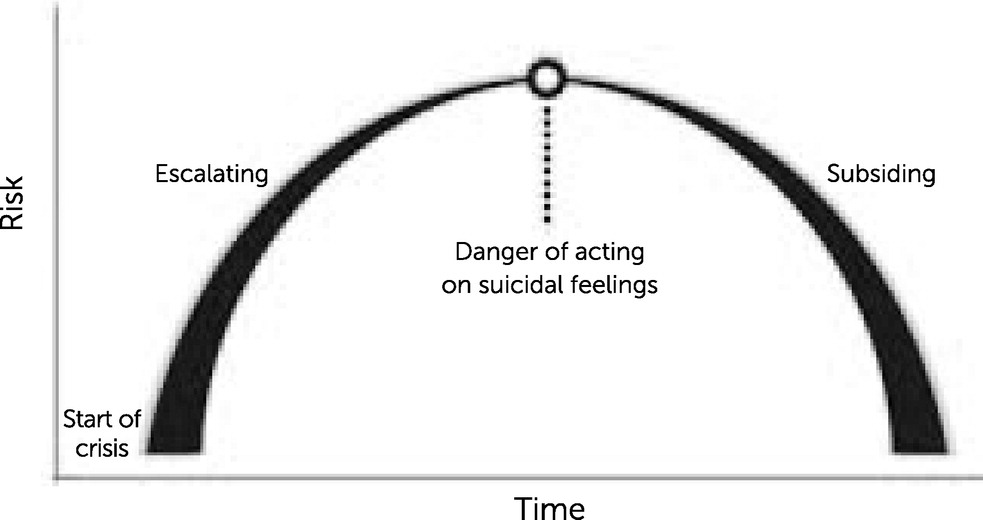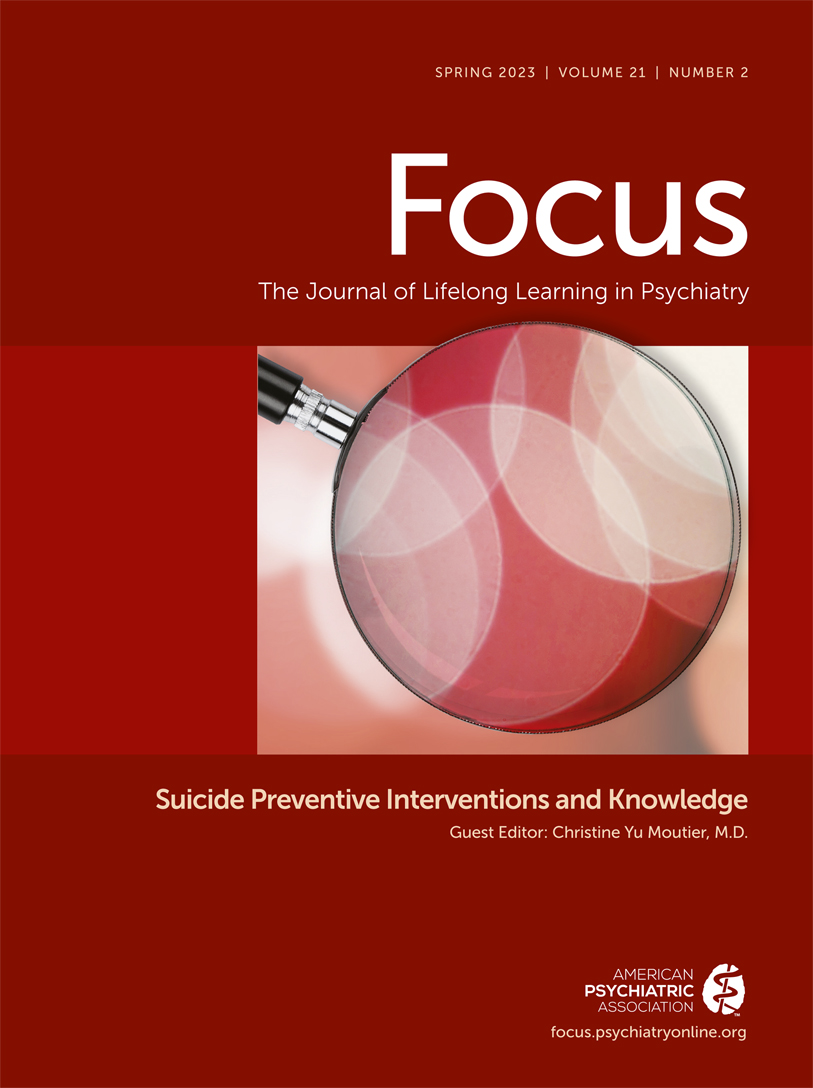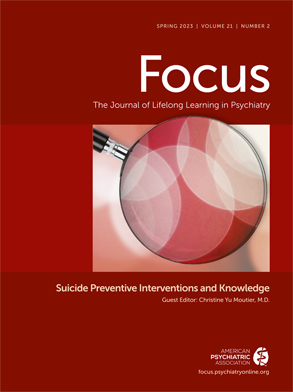Cognitive Therapy for Suicide Prevention (CT-SP)
CT-SP is a time-limited psychotherapy intervention that is based on Aaron Beck’s cognitive-behavioral model (
38). According to this theory, an individual’s biopsychosocial vulnerabilities can interact with suicidal thoughts and behaviors to produce a “suicide mode” (
38). CT-SP consists of an acute treatment phase consisting of approximately 10–12 structured weekly sessions, largely centered around the idea of applying CBT approaches to recognizing the suicide mode and knowing when one is in it and how to get out of it (
39). This acute treatment includes an early phase of crisis management, an intermediate phase consisting largely of skills training, and a later phase that addresses relapse prevention (
39). CT-SP also has a continuation phase, consisting of another six sessions provided across 12 weeks, as needed, after the acute treatment phase has been completed (
39).
A typical CT-SP session is about 50 minutes long and is quite structured (
38). The clinician and individual collaboratively set an agenda for the session, giving priority to suicidal ideation or to any life-threatening problems. The clinician conducts a mood and suicidal risk assessment, asks whether the safety plan has been used since the previous session, reviews homework, and focuses on new areas of cognitive restructuring and skills training.
During the first phase of the acute treatment protocol, which takes place across the first 2–3 sessions, the clinician conducts a thorough risk assessment and focuses on crisis management, which includes collaborative safety planning and means reduction counseling (
40). The clinician obtains a detailed narrative timeline identifying the major situations, thoughts, and behaviors surrounding the most recent suicidal crisis, which is then used to generate a cognitive-behavioral case conceptualization to inform an individualized treatment plan. In addition, because hopelessness is often associated with increased suicidal risk, the first phase of CT-SP includes identifying reasons for living and developing hope kits that can remind individuals of their reasons for living, and the things they have hope for, when they are in a more suicidal mode of thinking.
In the intermediate phase, emphasis is placed on learning coping skills targeted to the particular risk factors, triggers, and cognitive-behavioral responses that were identified in the individual’s crisis narrative (
41). These skills are based on evidence-based approaches, such as CBT and DBT, and include relaxation training, distraction, behavioral activation, self-care, and reduction of emotional vulnerability. Individuals are educated about the cognitive model and are taught how to restructure thoughts and beliefs that lead to the suicide mode and to modify dysfunctional core beliefs.
The later phase of CT-SP includes skills consolidation, relapse prevention, and treatment planning (
42). The central relapse prevention exercise is a task in which the individual is guided to imagine how they might use the skills, cognitive restructuring, and safety planning learned in the earlier phases to prevent acting on suicidal thoughts (
38). Once it is determined that the individual has consolidated the skills and can imagine using them and the safety plan, plans for further treatment, including a continuation phase of CT-SP, are considered.
In a well-powered RCT with an 18-month follow-up, Brown and colleagues (
43) found that individuals in CT-SP treatment were 50% less likely to reattempt suicide compared with those in the usual care group. The researchers also found significant reductions in levels of depression and hopelessness in the CT-SP treatment group compared with the control group. Researchers of CT-SP are in the process of replicating these results in a community-based outpatient setting, with varied samples (including those with severe ideation but who have not attempted suicide) (
44).
Brief Cognitive-Behavioral Therapy (BCBT) for Suicide Prevention
BCBT for Suicide Prevention, developed by Craig Bryan and M. David Rudd (
36) as a next step in the development, refinement, and application of the cognitive-behavioral model to reduce suicidal behavior, is an adaptation of CT-SP. Similar to CT-SP, BCBT consists of three phases of treatment, spanning 12 sessions. Phase 1, session 1, of BCBT consists of orientation to the treatment, narrative risk assessment, and crisis management, including development of a crisis response plan and lethal means reduction counseling (
36). Sessions 2–5 of phase 1 address treatment planning, skills for addressing sleep disturbance, mindfulness and relaxation, reasons for living and dying, and development of a survival kit. The primary tasks of phase 1 include describing the treatment, assessing the index suicidal episode, educating the client about the suicide mode, developing a crisis response plan, developing a treatment plan and obtaining the client’s commitment to the treatment, and providing training in emotion regulation skills.
Phase 2 (sessions 6–10) targets cognitive restructuring of suicidal belief systems, problem solving, and cultivation of cognitive flexibility (
36). In this phase, the clinician teaches selected cognitive-behavioral skills by using ABC (antecedent, behavior, and consequence) worksheets, identifying patterns of problematic thinking, asking challenging questions, and teaching the use of coping cards and activity planning. The primary tasks of phase 2 are to review and rehearse emotion regulation strategies, in order to generalize use of these strategies across situations, and to target core beliefs and behaviors that contribute to the suicide mode. Phase 3 (sessions 11–12) is devoted to relapse prevention. The primary tasks of phase 3 are to conduct relapse prevention tasks repeatedly, to review the index suicidal episode several times until the individual demonstrates the ability to problem solve, and to develop hypothetical future crises and conduct imaginal exposure with the client imagining effective use of problem-solving skills. The treatment is more fully described in a book or treatment manual (
36).
A number of studies have supported the effectiveness and efficacy of BCBT in reducing suicidal behavior. One RCT (
37) found that, among active-duty U.S. Army soldiers who had either attempted suicide or experienced suicidal ideation with intent, those who were assigned to the BCBT condition were 60% less likely to attempt suicide in the 24 months between baseline and follow-up than those assigned to treatment as usual. In a secondary analysis of the same participant sample (
6), three latent classes corresponding to low, moderate, and high suicide risk were identified, with classes significantly differing in terms of psychiatric symptom severity but not in demographic or historical variables. Rates of suicide attempts during the 2-year follow-up period significantly varied across these classes among those in the treatment-as-usual group, but did not vary across classes in the BCBT group, indicating that BCBT contributed to consistently low rates of suicidal behavior, despite psychiatric symptom severity (
6).
Collaborative Assessment and Management of Suicidality (CAMS)
CAMS (
45,
46) is a therapeutic framework that guides clinicians in assessing, tracking, and treating clients’ suicidal risk and typically takes 6–8 sessions. A core feature of CAMS is the collaborative and transparent way in which clinicians work with clients to comprehensively assess and safely manage suicide risk (
45). Assessment and management of risk are guided by Suicide Status Forms (SSFs), which are used to assess multiple dimensions of suicide risk, track risk fluctuations over time, assist with planning treatment to target “drivers” of risk, and evaluate treatment outcomes (
47). The SSF and CAMS are based on Shneidman’s cubic model of suicide (
48), which posits that suicidal behavior and death result from “psychache” (i.e., psychological pain), perturbation, and stress. Other conceptual influences on the CAMS framework include Beck’s theory of hopelessness (
49) and Baumeister’s view of self-hate as a driving factor of suicide (
50). Jobes proposes that these factors are critical to assess and target in treatment (
45).
In the first part of the SSF, clients are asked to rate their current experience of six dimensions of suicide risk and then to rank them in order of importance: psychological pain, stress, agitation, hopelessness, self-hate, and overall suicide risk (overall suicide risk is not ranked) (
51). Clients then rate the extent to which their suicidal thoughts are related to themselves versus others, list and rank their reasons for living and for dying, rate how much they want to live versus how much they want to die, and indicate the “one thing that would help me no longer feel suicidal” (
46). Later portions of the SSF include a treatment plan that the clinician and client codevelop, traditional suicide risk assessment items for the clinician to complete (e.g., frequency and duration of ideation, history of suicidal behaviors), and a stabilization plan—which is similar to a safety plan (
19) or crisis response plan (
10).
The CAMS approach calls for the clinician to physically sit next to the client while the two together complete the SSF. By sitting next to the client, the clinician is demystifying therapy; the client can see what is on the SSF and what the clinician is writing. This gesture of sitting next to the client is used in part to convey the message that the two are on the same team, and that the client’s input in treatment is encouraged and expected (
46). Jobes notes that this arrangement differs from the traditional medical model, which approaches treatment in a more directive way, where the clinician is deemed to be the expert in suicide who knows what is best for the suicidal client. In that scenario, the client is directed to follow the clinician’s suggestions without much input, if any. The CAMS approach, on the other hand, recognizes that clients are experts in their own experience of suicidal risk and that it is the clinician’s job to develop a shared understanding of this perspective and to work with clients to address the risk in a way that is acceptable to both parties. Because CAMS is a flexible framework, it can be used with a range of interventions from varying theoretical backgrounds (e.g., cognitive-behavioral, psychodynamic, humanistic).
A growing number of studies have tested the efficacy and effectiveness of CAMS compared with treatment as usual (
52,
53). CAMS has largely been tested among civilian adults in outpatient settings, although a few studies have been conducted in inpatient units or EDs (
54,
55) or with active-duty military personnel (
56,
57).
In adult populations, CAMS has demonstrated effectiveness in reducing suicidal ideation and overall symptom distress, compared with treatment as usual (
53), but not in reducing suicidal behavior (
52). These gains have been sustained for 12 months after treatment was completed in some studies (
58), although not every trial has found this same effect (
59). Participants in CAMS trials have also exhibited improvements in suicide ideation and distress from pre- to posttreatment (
60) and quicker reduction in suicide ideation (in ∼6–8 sessions), compared with treatment as usual (
56,
61). In addition, participants who have received CAMS have reported significant increases in hope (
58), greater decreases in hopelessness (
59,
62), and lower rates of ED visits (
56). Furthermore, CAMS treatment has been associated with greater client satisfaction (
58,
59), treatment retention (
58,
59), and treatment acceptability and feasibility (
54,
63).
In a trial comparing CAMS to DBT, however, CAMS was not superior on any outcome variable (e.g., suicide ideation, suicide attempt, nonsuicidal self-injury, hopelessness) among clients with borderline personality disorder who had recently attempted suicide (
62). Furthermore, to our knowledge, no published RCT to date has demonstrated a significant effect of CAMS in reducing suicide attempts or self-harm. More research is needed to better understand the effect of CAMS on suicide-related behaviors.
The Coping Long-Term With Active Suicide Program (CLASP)
Ivan Miller and colleagues (
64) have developed a brief suicide prevention intervention meant to reduce subsequent suicidal behavior during times of acute risk. The CLASP is an adjunctive intervention consisting of three individual in-person meetings, one meeting with the individual’s significant other or family, and 11 15–30-minute telephone contacts with the suicidal individual and his or her significant other or family member.
The CLASP intervention adapts strategies from Acceptance and Commitment Therapy (ACT) (
65) and from Family Intervention-Telephone Tracking (FITT) (
66) to reduce modifiable risk factors for suicide. Thus, the intervention aims to reduce hopelessness, bolster family and social support, teach problem-solving skills, and enhance treatment engagement. CLASP also focuses on identifying individual-specific risk factors.
During the initial meetings with the individual, a discussion informed by the ACT approach is begun to clarify the individual’s personal values toward facilitation of behavioral change (
67). The focus on values leads to the setting of goals that are consistent with the individual’s beliefs. This approach is later extended to the meeting with the individual and their significant other or family member (SO) and results in an individualized life plan document that informs the telephone contacts.
Subsequent telephone contacts with the individual and their SO are modeled after the FITT intervention and are aimed at problem solving, including improvement of communication skills and monitoring of suicide risk (
64). These telephone contacts also support problem-solving coping skills and enhanced treatment engagement by addressing any treatment barriers. The intervention is not considered to be psychotherapy—rather, the clinician is considered an advisor who takes a case-management type of approach.
In the first three sessions, the advisor meets with the individual, introduces the program, obtains a psychiatric history, evaluates current suicide risk status, develops or reviews a safety plan, begins a discussion of the individual’s values, and develops short-term treatment goals (
64). This phase culminates in development of a life plan document that guides the telephone call component of the intervention. When the SO is included, in the fourth meeting, there is brief psychoeducation regarding suicide and suicide risk factors and a review of the life plan, which includes a safety plan.
Following these in-person meetings, the advisor conducts 11 15–30-minute telephone contacts with the suicidal individual and also with the SO separately (
64). If no SO can be identified, the calls are conducted with the suicidal individual only. Frequency of these telephone contacts decreases across 6 months. The advisor monitors suicide risk, and when suicidality is present, the safety plan is reviewed. The advisor encourages problem solving and communication and discusses problems in terms of the identified values and the life plan document. Because CLASP is an adjunct treatment, when necessary, the advisor may contact the primary treatment provider.
In an initial open trial, CLASP was administered to 25 inpatients at risk for suicide (
64). The in-person sessions were conducted on the unit, and the telephone calls were conducted during the 6 months postdischarge. CLASP was acceptable to about 75% of the clients, and most were able to identify a SO. Satisfaction with CLASP was high, and the 12% of clients who subsequently attempted suicide within the 6-month period represented a significantly lower number than previous subsequent suicide attempt rates among former inpatients. A pilot RCT (
64) included an enhanced treatment-as-usual condition, called Safety Assessment and Follow-Up Evaluation (SAFE), which consisted of treatment as usual, plus enhanced monitoring of suicidal ideation and risk factors. Compared with control group participants, those receiving CLASP had lower rates of suicide attempts and hospitalizations during the 6-month follow-up. Thus, there is evidence for feasibility and acceptability of the CLASP intervention, as well as some promising pilot efficacy data.


